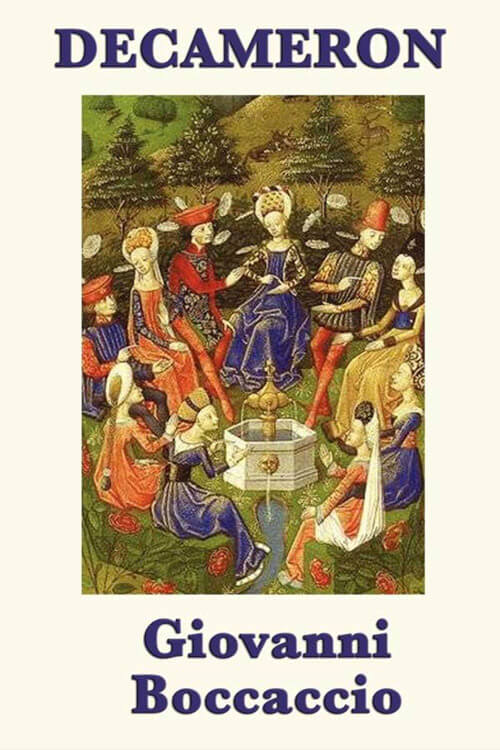
The Decameron of Giovanni Boccaccio
The Decameron or Decamerone, subtitled Prince Galehaut and sometimes nicknamed l’Umana commedia (“the Human comedy”, as it was Boccaccio that dubbed Dante Alighieri’s Comedy “Divine”), is a collection of short stories by the 14th-century Italian author Giovanni Boccaccio (1313–1375). The book is structured as a story frame containing 100 tales told by seven young women and three young men; they sheltered in a secluded villa just outside Florence to escape the Black Death afflicting the city. Boccaccio probably conceived of the Decameron after the epidemic of 1348 and completed it by 1353. The various tales of love in The Decameron range from the erotic to the tragic. Tales of wit, practical jokes, and life lessons contribute to the mosaic. In addition to its literary value and widespread influence (for example, in Chaucer’s Canterbury Tales), it provides a life document of the time.
Written in the vocabulary of the Florentine language, it is considered a masterpiece of classical early Italian prose. In Italy during the Black Death, seven young women and three young men fled from plague-ridden Florence to a deserted villa in the countryside of Fiesole for two weeks. To pass the evenings, each party member tells a story each night, except for one day per week for chores and the holy days during which they do no work, resulting in ten nights of storytelling over two weeks. Thus, by the fortnight’s end, they had told 100 stories. Each of the ten characters is charged as King or Queen of the company for one of the ten days in turn. This charge extends to choosing the theme of the stories for that day. All but two days have topics assigned: examples of the power of fortune, examples of the power of human will, love tales that end tragically, love tales that end happily; clever replies that save the speaker, tricks that women play on men, tricks that people play on each other in general; examples of virtue. Due to his wit, Dioneo, who usually tells the tenth tale daily, can select any topic he wishes.
Many commentators have argued that Dioneo expresses his views of Boccaccio. Each day also includes a short introduction and conclusion to continue the frame of the tales by describing other daily activities besides story-telling. These framing interludes frequently include transcriptions of Italian folk songs. The interactions among tales in a day, or across days, as Boccaccio spins variations and reversals of previous material, form a whole and not just a collection of stories. Recurring plots of the stories include mocking the lust and greed of the clergy; female lust and ambition on a par with male lust and ambition; tensions in Italian society between the new wealthy commercial class and noble families; and the perils and adventures of travelling merchants.
Read or download Book
Giovanni Boccaccio
Giovanni Boccaccio (16 June 1313 – 21 December 1375) was an Italian writer, poet, correspondent of Petrarch, and an important Renaissance humanist.
Biography
Born in the town of Certaldo, he became so well known as a writer that he was sometimes known as “the Certaldese” and one of the most influential figures in the European literary panorama of the fourteenth century. Some scholars (including Vittore Branca) define him as the most significant European prose writer of his time. He is a versatile writer who amalgamated different literary trends and genres, making them converge in original works, thanks to a creative activity exercised under experimentalism. His most notable works are The Decameron, a collection of short stories that in the following centuries was a determining element for the Italian literary tradition, significantly after Pietro Bembo elevated the Boccaccian style to a model of Italian prose in the sixteenth century, and On Famous Women.
He wrote his imaginative literature mostly in Tuscan vernacular, as well as other works in Latin, and is particularly noted for his realistic dialogue, which differed from that of his contemporaries. These medieval writers usually followed formulaic models for character and plot. The influence of Boccaccio’s works was not limited to the Italian cultural scene but extended to the rest of Europe, exerting influence on authors such as Geoffrey Chaucer, a key figure in English literature, or later on, Miguel de Cervantes, Lope de Vega, and the Spanish classical theatre. Boccaccio Dante Alighieri and Petrarch are part of the so-called “Three Crowns” of Italian literature. He is remembered for being one of the precursors of humanism, of which he helped lay the foundations in the city of Florence, in conjunction with the activity of his friend and teacher Petrarch. He was the one who initiated Dante’s criticism and philology: Boccaccio devoted himself to copying codices of the Divine Comedy and was a promoter of Dante’s work and figure. In the twentieth century, Boccaccio was the subject of critical-philological studies by Vittore Branca and Giuseppe Billanovich, and his Decameron was transposed to the big screen by the director and writer Pier Paolo Pasolini.






